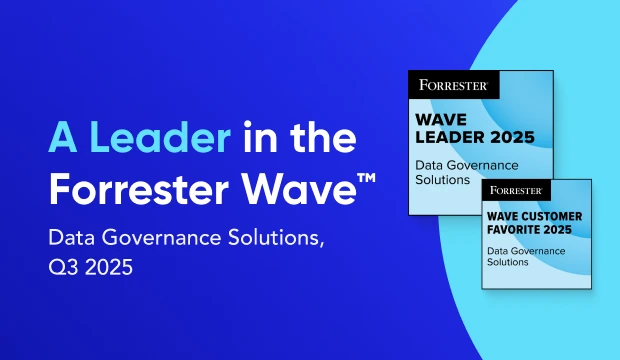Metadata vs Master Data: 15 Key Differences & Examples!

Share this article
Metadata vs master data: What’s the difference? #
Metadata provides information about data, including its context and characteristics, whereas master data consists of unchanging core elements like customer or product information, serving as a foundational reference for business operations.
Understanding the differences between these two foundational elements is essential for any organization looking to harness the power of its data. In essence, metadata describes data, while master data is essential for business transactions and analysis.
Recognizing the unique roles and interplay between metadata and master data is what allows businesses to effectively manage and utilize their data assets for strategic advantage.
Modern data problems require modern solutions - Try Atlan, the data catalog of choice for forward-looking data teams! 👉 Book your demo today
In this article, we will explore:
- Definition of metadata and master data
- Differences between metadata and master data
- Using reference data to explore it beyond the basic
- 8 Real-world examples for both
- Metadata and master data management
- Relation between them
So, let’s dive in!
Table of contents #
- Metadata vs master data: What’s the difference?
- What is metadata?
- What is master data?
- Metadata vs master data: 15 Key differences between them
- Metadata vs master data vs reference data
- 8 Real-world examples of metadata vs master data
- Metadata management vs master data management: 9 Differences between them
- How metadata is related to master data management?
- Conclusion
- Metadata vs master data: Related reads
What is metadata? #
Metadata is often described as “data about data.” It’s the information that summarizes the basic details of data, making finding and working with particular instances of data easier.
For instance, when you take a photo with your smartphone, the metadata includes not just the image itself but also details like the date and time the photo was taken, the location (if location services are on), the camera used, and the file size.
In the world of business and data management, metadata serves as a guide to understanding information stored in databases. Imagine you have a massive warehouse full of boxes; metadata is like the labels on those boxes that tell you what’s inside without having to open them.
It helps organize data by providing context, which can be crucial for efficiency in operations like data mining, archiving, and retrieval. For SaaS companies, metadata is particularly valuable. It can help manage customer information, track software versions, and improve service by making sure the right data is easily accessible.
It’s not just about having data; it’s about making that data understandable and usable. Metadata turns a chaotic jumble of information into a neatly organized directory, facilitating better decision-making and streamlined business processes.
What is master data? #
Master data is the core information that is essential for the operations within an organization. This includes details about customers, products, employees, and suppliers—information that is crucial for transactions and company records. It’s the kind of data that doesn’t change often but is used regularly to run a business.
Imagine it as the backbone of a company’s information system: the key facts that everyone in the company uses to carry out their tasks. Whether it’s processing orders, shipping products, or providing service, master data is the information that keeps the whole process running smoothly.
Keeping master data accurate and consistent is vital for a business. It ensures that every department—from sales to customer service—has the right information they need to do their job effectively. Without accurate master data, a company could face miscommunication, inefficiencies, and errors that impact operations and decision-making.
Metadata vs master data: 15 Key differences between them #
Metadata provides information about other data, while master data represents the foundational and consistently maintained data shared across an organization, such as customer or product information.
And despite their interconnected roles in data-driven decision-making, they serve distinct functions.
Let us look at 15 key differences metadata and master data them in a tabular format:
| Aspect | Metadata | Master data |
|---|---|---|
| Definition | Metadata is the data providing information about other data's nature, origin, and structure. It's similar to a library's card catalog, describing the content without being the content itself. | Master data describes the main subjects of business transactions and operations, like the books in a library, offering the substantive content around which business revolves. |
| Purpose | Aids in data identification, retrieval, and management by outlining data properties. | Central to conducting business operations, like processing transactions and maintaining records. |
| Stability | Dynamic, changes with data structure or context updates. | Relatively stable, changes with significant business updates or transformations. |
| Usage in processes | Predominantly used in data governance, quality control, and IT operations. | Integral to transactional processes and core business operations. |
| Storage | Often stored in data dictionaries, catalogs, and schemas. | Typically stored in centralized databases and ERP (Enterprise Resource Planning) systems. |
| Impact on data-related activities | Influences data quality, user understanding, and compliance with standards. | Ensures consistency and accuracy across various business activities. |
| Automation | Can be automated, as in the extraction of metadata during data ingestion processes. | May require manual input or validation to maintain the integrity of business-critical information. |
| Role in compliance | Facilitates adherence to data standards and legal compliance. | Essential for maintaining accurate business records and transaction reporting. |
| Types of information | Includes data about structure, type, and usage, such as file size, creation date, and permissions. | Comprises information about business entities, like customer names, product IDs, and supplier details. |
| Visibility to end-users | Not typically visible or directly interacted with by end-users. | Directly viewed, managed, and utilized by end-users in their daily activities. |
| Management focus | Managed through metadata management strategies to support data integration and interoperability. | Managed via master data management practices to ensure uniformity and precision across systems. |
| Relevance to systems | Critical for the functionality of data analysis and Business Intelligence (BI) tools. | Key to the operation of CRM (Customer Relationship Management), SCM (Supply Chain Management), and ERP systems. |
| Information nature | Technical and descriptive, often dealing with IT and data stewardship. | Business-oriented, dealing with operational processes and analytics. |
| Necessity for integration | Ensures data from various sources can be integrated cohesively. | Vital for the integration of business processes and systems. |
| Influence on data models | Guides the creation and adaptation of data models to reflect data relationships and structures. | Serves as a foundation upon which data models are built, providing the key entities around which business revolves. |
“Metadata vs master data” is not just a comparison of terms but a foundational element of data strategy. Understanding these distinctions is not merely academic; it’s practical, impacting everything from IT infrastructure to business analytics.
By outlining metadata and master data, organizations can establish a robust framework for data management that supports growth, innovation, and efficiency.
Metadata vs master data vs reference data: Beyond the basics! #
When working with data, it’s easy to get stuck because of the various terms that are there in the data world. Three that often come up are metadata, master data, and reference data.
Each plays a unique role in how data is organized, understood, and used within a business. Think of them as members of a sports team: each has a position to play, but they all contribute to the same goal.
Let’s look at the difference between metadata, master data, and reference data in a tabular format:
| Metadata | Master data | Reference data |
|---|---|---|
| Provides information about other data, like a label on a file. | The core data that is key to business operations, like the content inside the file. | Data is used as a standard for categorizing other data, similar to a set of folder tabs for a filing cabinet. |
| Typically technical in nature, such as file size or data lineage. | Concerns business concepts, like customer profiles or product information. | Includes predefined lists and codes, like country codes or department IDs. |
| Highly dynamic, can change frequently as it describes relationships and contexts. | Generally stable, with infrequent but critical updates. | Changes only when necessary to reflect new standards or categories. |
| Aids in data discovery and organization. | Integral to transactional processes and decision-making. | Ensures uniformity and validation in master data entries. |
| Managed via metadata management systems. | Managed through Master Data Management (MDM) practices. | Often managed within MDM as well to maintain consistency. |
| Not directly manipulated by business users. | Regularly updated and maintained by business users. | Rarely seen or modified by users, it acts as a background framework. |
| Crucial for IT and data governance. | Directly impacts operational efficiency and customer relations. | Acts as a reference guide for allowable data values in transactions and reports. |
| Enhances the interoperability of data systems. | Ensures a "single version of the truth" across the business. | Provides context and standardization for data analytics. |
| Facilitates compliance with data privacy and retention policies. | Drives strategic business initiatives and accurate reporting. | Supports regulatory compliance and data integrity. |
Now that we’ve unpacked these terms, it’s clear that metadata, master data, and reference data are the unsung heroes of the data management world. They ensure that everyone speaks the same language and follows the same playbook.
By understanding the distinct roles and functions of each, businesses can better organize their data, make informed decisions, and maintain high data quality. It’s not just about having data; it’s about making it work for you in the most efficient and insightful ways possible.
8 Real-world examples of metadata vs master data #
When it comes to data management, nothing beats clear, real-world examples to illustrate the concepts of metadata and master data. By walking through practical scenarios, we can see how metadata and master data play different yet crucial roles in everyday business operations.
Let’s dive in and explore these terms through tangible applications that show just how they impact the data-driven decisions of modern organizations.
Here are 8 real-world examples of metadata and master data:
- E-commerce product listings
- Library catalog system
- Healthcare patient records
- Financial reporting systems
- Customer relationship management software
- Manufacturing product lifecycle management
- Retail inventory management
- Human resources management systems
Let’s look into each of the above examples in brief:
1. E-commerce product listings #
- Metadata: Online shopping is smooth because metadata works behind the scenes. It includes image file types, update timestamps, and tags for search engine optimization. It’s the backstage crew that ensures the product’s online presence is not just visible but organized and searchable.
- Master data: The displayed product details like names, prices, and SKUs are master data. They’re the front-stage stars, providing customers with consistent and crucial information for making purchase decisions.
2. Library catalog system #
- Metadata: In a library’s digital catalog, metadata covers the book’s accession date, classification code, and format. It’s the librarian’s map, directing to the right shelf and section.
- Master data: The book’s title, author, ISBN, and publisher are master data. They’re the library’s inventory, detailing what’s in stock for lending and reference.
3. Healthcare patient records #
- Metadata: Healthcare records are secure and organized because metadata tracks record creation dates and access levels. It’s the gatekeeper, ensuring patient data is safe and only seen by the right eyes.
- Master data: Patient names, medical histories, and treatment plans are master data. They’re the doctor’s facts, crucial for providing accurate care.
4. Financial reporting systems #
- Metadata: Financial metadata includes account coding, fiscal calendars, and report templates. It’s the accountant’s rulebook, ensuring reports are correct and compliant.
- Master data: Actual transaction amounts and account balances are master data. They’re the financial scoreboard, showing a company’s economic game in real time.
5. Customer Relationship Management (CRM) software #
- Metadata: CRM metadata defines data field rules like character limits for feedback or phone number formats. It’s the CRM’s instruction manual, guiding data entry and user access.
- Master data: Customer names, contact details, and interaction logs are master data. They’re the CRM’s diary, holding the history and details of customer relationships.
6. Manufacturing product lifecycle management #
- Metadata: Design document versions and edit dates in manufacturing are metadata. They’re the blueprint annotations, tracing each change to maintain quality.
- Master data: Product specs, materials, and instructions are master data. They’re the factory floor’s guide, ensuring each product is made to standard.
7. Retail inventory management #
- Metadata: Retail metadata tracks when and by whom inventory counts are performed. It’s the inventory tracker, providing insights into stock status and movements.
- Master data: Product names, quantities, and prices on the shelf are master data. They’re the retailer’s catalog, the key to sales and supply chain management.
8. Human resources management systems #
- Metadata: HR metadata includes information about the structure and permissions of employee data. It’s HR’s filing system, keeping employee details confidential and well-organized.
- Master data: Employee demographic and job details are master data. They’re the HR ledger, crucial for managing careers, payrolls, and benefits.
These examples highlight the distinct roles that metadata and master data play in a variety of sectors and systems. While metadata is the backstage manager, ensuring that data is stored, retrieved, and understood correctly, master data is the star performer, providing the essential information that keeps the daily business show on the road.
Recognizing the difference helps organizations manage their data more effectively, leading to improved operations, better customer experiences, and more strategic decision-making.
Metadata management vs master data management: 9 Differences between them #
Imagine you’re in a bustling kitchen with all kinds of ingredients and recipes. In this scenario, metadata management is like labeling and organizing the ingredients so chefs can find them easily, while master data management is making sure that the ingredients are fresh and the recipes are consistent for every dish made.
Both are crucial: one keeps the kitchen in order, and the other ensures the meals are delicious every time. Now, let’s apply this to data in the business world and see how these two management styles differ, keeping things as straightforward as a recipe card.
Let us look at the differences between them in a tabular format:
| Aspect | Metadata management | Master data management |
|---|---|---|
| Definition & focus | Centers on the description, context, and cataloging of data elements. | Concentrates on the accurate, unified management of core business information. |
| Primary goal | To streamline data identification, accessibility, and governance. | To ensure the uniformity and precision of data across the business. |
| Scope of data | Deals with data structure, format, and policies. | Deals with business entities like customers, products, and vendors. |
| Impact on business | Enhances data usability and compliance. | Directly affects operational processes and strategic decision-making. |
| Key activities | Involves tagging data, creating metadata repositories, and setting standards. | Involves cleansing data, preventing duplication, and harmonizing data sources. |
| End-user interaction | Often indirect, with IT departments handling the intricacies. | Direct, with business users actively engaging with the data. |
| Change management | Metadata is dynamic, changing with data definitions and usage. | Master data changes with business transformations. |
| Tools and applications | Utilized by technical users to manage data types and relationships. | Utilized by business users to manage customer and product data. |
| Business value | Ensures data is understandable and correctly integrated into systems. | Provides a consistent, accurate view of key business entities. |
| Governance and standards | Focuses on establishing and enforcing data description standards. | Focuses on creating and maintaining accurate data for business use. |
| Quality and integrity | Maintains the accuracy of data descriptions and relationships. | Maintains the accuracy and consistency of essential business data. |
| Usage in operations | More about managing the metadata lifecycle and its systems. | More about managing actual business processes and analytics. |
| Visibility | Usually not visible to end-users but crucial for backend data handling. | Highly visible and frequently interacted with by end-users. |
| Frequency of change | More frequent updates due to changes in data context or structure. | Infrequent updates, usually driven by significant business events. |
| Compliance and regulation | Helps in adhering to data standards and legal requirements. | Ensures that business transactions are accurate and auditable. |
By breaking down the nitty-gritty of metadata and master data management, we can see how both are essential to the smooth operation of a business’s data systems. Metadata management keeps the data neat and organized, like a well-plotted map, while master data management ensures the information itself is trustworthy and reliable, like a compass guiding you.
In our data-driven world, understanding these two approaches isn’t just useful for tech teams; it’s critical for anyone looking to get ahead in the digital world. Think of them as two sides of the same coin, each invaluable and necessary for modern business success.
Want to learn more? Read more → Metadata management vs master data management
How metadata is related to master data management? #
When we talk about data management, we often hear about two types of data: metadata and master data. Each has its place in the grand data scheme, but their relationship is symbiotic. Like the roots and branches of a tree, metadata feeds into and supports master data management.
Understanding how metadata interplays with master data is key for any data-driven business. It’s not just about knowing the difference between metadata vs master data; it’s about seeing how they connect and why that connection matters.
Here’s how metadata is related to master data management:
- Metadata as the roadmap for master data
- Metadata for data quality assurance
- Improving master data consistency
- Facilitating data governance
- Enabling data integration
- Support for data migration projects
- Enhancing data analysis and reporting
- Supporting master data management tools
Let’s look into each of the above aspects in brief:
1. Metadata as the roadmap for master data #
Metadata serves as a roadmap that guides users to the right piece of master data. Like signposts, metadata provides the necessary directions and details to navigate the complex pathways of a company’s data infrastructure.
When managing master data, such as customer information, metadata helps identify the source, history, and structure of that data, ensuring that the master data is not only accurate but also accessible.
2. Metadata for data quality assurance #
Metadata plays a crucial role in ensuring the quality of master data. By describing the quality rules, source system, and lineage, metadata acts as a quality checkpoint.
It tells us whether the master data can be trusted, how it’s been processed, and what it should look like, which is essential for maintaining the integrity of the data throughout its lifecycle.
3. Improving master data consistency #
The consistency of master data across different systems is made possible through metadata.
It defines and standardizes the format and relationships of master data elements, making sure that, for example, ‘Customer ID’ means the same thing across all systems and datasets within an organization.
4. Facilitating data governance #
Metadata supports data governance by documenting the policies and procedures that apply to master data. It details who owns the data, who can access it, and how it can be used.
This layer of governance is crucial in managing the master data effectively and in compliance with regulations.
5. Enabling data integration #
When integrating master data from various sources, metadata is what makes sense of it all.
It describes how different data sets relate to each other and maps out the relationships, which is crucial for merging data from different systems without losing meaning or creating discrepancies.
6. Support for data migration projects #
In data migration projects, metadata is indispensable. It helps identify which master data to migrate, the rules for transformation, and how to map data from the old system to the new one.
This ensures that the master data retains its value and significance during and after the migration.
7. Enhancing data analysis and reporting #
Metadata enriches master data by providing context for analysis and reporting. It explains what the master data represents, which is critical for interpreting reports and analytics accurately.
Without metadata, master data could be misinterpreted, leading to flawed business decisions.
8. Supporting master data management tools #
Master Data Management (MDM) tools rely heavily on metadata to operate efficiently. These tools use metadata to create models of master data, automate data management processes, and ensure that the data they manage fits the business requirements and rules.
Metadata is the unsung hero behind the scenes, ensuring that master data shines in the spotlight of a company’s operations with precision and context. Together, they form a crucial partnership, each dependent on the other to offer a full view of an organization’s data narrative.
Recognizing their interdependence is not just a technical exercise but a strategic necessity for any data-driven business, as it significantly influences their ability to harness data effectively.
Conclusion #
Alright, we’ve talked a lot about metadata and master data. In a nutshell, metadata describes data, while master data is the core, high-quality data shared and used consistently across an organization.
We’ve gone through their differences, how they stack up against reference data, and given examples to show how they work in real life. We also touched on how managing each type is a different ball game.
So, there you have it. Metadata and master data are a bit like a map and a car. The map (metadata) helps you understand where you’re going, and the car (master data) gets you there. Both are super important for businesses to keep things running smoothly and make smart choices. Hope this makes your data journey a bit easier!
Metadata vs master data: Related reads #
- Metadata: Definition, Examples, Benefits & Use Cases
- Master Data vs. Transactional Data: Unveiling the Data Symphony
- Master Data Management and Metadata Management: How are They Different?
- Data Catalog Vs. Metadata Management: Differences, and How They Work Together?
- Why is Metadata Important for Effective Data Management?
- Data Governance and Metadata Management: Understanding Their Synergy for Data-Driven Success
- Reference Data: Types, Examples & Differences in 2023
- Metadata Management and Data Lineage: How Their Synergy Enhances Data Understanding and Data Governance
- Metadata Management: Benefits, Automation, Use cases, and Framework
Share this article











